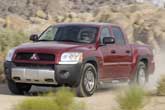Recent Articles
Popular Makes
Body Types
2006 Mitsubishi Raider First Drive
The three-diamond marque hopes to trump with its new truck
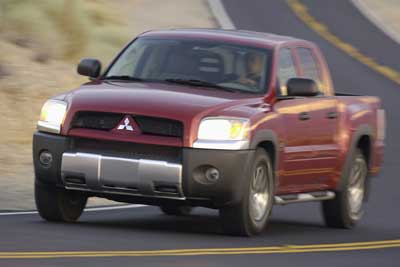
PORTLAND, Ore. – Portland and its environs are all about scenery. From the Willamette River and spectacular Columbia River Gorge to the snow-capped summits of Mounts Hood and St. Helens, there are images and vistas that will swell your heart and your digital camera’s photo chip. It’s also a region known for its history – for American explorers Lewis and Clark and the native cultures that predated them – carrying forward its rich traditions today.
The same could be said for the 2006 Mitsubishi Raider that we recently drove through this region. It’s all about scenery. This new mid-sized truck is the product of an alliance with DaimlerChrysler and, if you took a picture underneath, you’d see that it’s really the Dodge Dakota, with Mitsubishi design cues fashioned to morph both the outside appearance and the cockpit ambiance into a truck that looks more sporty and sophisticated.
The new Raider is also powered by Dodge engines; shifts with Dodge transmissions; and steers, brakes and rides over pavement and dirt using the same exact equipment found on the popular and upgraded-for-2005 Dodge Dakota. But it gets a better warranty than the Dodge, offering an additional two years and 24,000 miles of powertrain and basic coverage over the Dakota.
The new Mitsubishi truck is about history, as well. As this Japanese automaker tries to get its sales wheels spinning again and rebuild its brand in America, the Raider – Mitsubishi’s first truck in more than a decade – joins an upgraded stable of models being advertised with the trendy, urban imagery of ‘J-Cool’ (Japanese-cool), tribal graphics and music, an ancient and powerful form of Japanese drumming. Developing a new ad campaign – Driven to Thrill – that will run across its car, sport-utility vehicle and new truck lines, this Asian manufacturer wants to call forth its Japanese DNA and create a cohesive new image of its full product line that will appeal to more adventuresome buyers who set themselves apart from the crowd.
We came to beautiful northwestern Oregon to look beyond the pretty scenery, however, and to see beyond the urban hip of J-Cool and drums. We came to drive this new truck and assess whether Mitsubishi has forged an identity of its own with its rebadged Dodge Dakota. What we found was a sculpted truck designed to attract young buyers and fun-seekers. The 2006 Mitsubishi Raider brings to market notable features, such as a V8 engine and the ability to carry six, making it an appealing offering in a competitive and still-growing market.
On sale in late September, prices for the 2006 Mitsubishi Raider will range from below $20,000 to around $30,000. Mitsubishi expects that 65 percent of sales will be 2WD, 35 percent part-time 4WD and 10 percent full-time 4WD. As for its success, exact pricing and probable incentives will likely carry more weight than tribal graphics and drums. But, as much as Mitsubishi has high hopes for its new truck, this three-diamond marque has higher hopes to trump with its new product line theme – Driven to Thrill.
Model Mix
Model Mix With the 2006 Mitsubishi Raider, choose between two drivetrains, two transmissions, three trim levels, Extended and Double Cab styles, several wheel and tire packages, and upscale options. Although all 2006 Mitsubishi Raider pickups share dimensions, several trim levels paired with two distinct body styles provide a wide range of configurations to suit different buyers. In sheet metal terms, customers must give preference to either the cabin or cargo box. Extended Cab Raiders use two small rearward swinging doors to access the cramped rear seats, while Double Cab models get four full-size, forward-swinging portals. The box behind the shorter Extended Cab stretches six feet, six inches while Double Cab models make due with an abbreviated five-foot, three-inch box. Dodge calls the similarly configured Dakota either the Club (Extended) or Quad (Double) Cab. Base LS models are equipped with a 3.7-liter V6 engine, the same one found in the lower end of the Dakota lineup. Two transmissions – a six-speed manual or four-speed automatic – determine the gear ratio sent to all four corners or solely to the rear wheels, as all trim lines are available in either 2WD or 4WD. The standard LS trim brings air conditioning, tinted glass, manually-adjusted sideview mirrors, tachometer, a single-disc CD player with four speakers, a 40/20/40 split front bench seat, and 16-inch steel wheels wrapped in 245/70R16 all-season tires. Adding the optional Power and Convenience Package adds more goodies, with power windows, locks and mirrors; keyless entry; rear seating; floor mats; a tilt steering wheel; and cruise control. Upgrading to the DuroCross V6 trim strengthens the standard feature list considerably, including fog lamps, fender flares with mud guards, a bed liner, exterior side steps, darker window tinting, a sliding rear window, a leather-wrapped steering wheel, DuroCross floor mats, a heavy-duty cooling system, and 16-inch alloy wheels inside 265/70R16 all-season tires. Opting for 4WD in this version sets you up with LT265/70R16 B.F. Goodrich all-terrain tires, high-pressure gas shocks, a limited-slip differential, and a skid plate package. Options include larger power-adjusted and heated 6x9-inch exterior mirrors, a hood protector, wheel locks, a spare tire lock and a bed rail protector. DuroCross V6 models are also available with the Sound Option Package, which features a six-disc CD changer, Sirius satellite radio, steering wheel-mounted audio controls, and a subwoofer. Interestingly, front bucket seats flanking a full floor console are also included with the Sound Package. In addition to a 4.7-liter V8 engine and five-speed automatic transmission, DuroCross V8 models are trimmed with machine-finished alloy wheels; a power driver's seat; Bluetooth hands-free cell communications technology; satin interior accents; and a heavy-duty Towing Package with a Class IV receiver, 7-pin wiring harness, 4 to 7-pin wiring adaptor, limited-slip differential, and a 3.92:1 rear axle ratio.
At the top end, XLS Double Cab models get the V8 engine and five-speed automatic tranny, but also include an automatic dimming rearview mirror, front bucket seats, rear window defroster, standard power 6x9-inch heated mirrors, leather seats with front heaters, available full-time 4WD, 17-inch chrome wheels with 265/65R17 tires, the Towing Package, and the Sound Option Package – called High-Output Audio in this version.
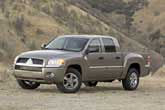
Nuts and Bolts
Nuts and Bolts In the 2006 Mitsubishi Raider, a standard 3.7-liter V6 delivers 210 horsepower and the optional V8’s output measures 230 horsepower. Towing capacity is as high as 6,500 pounds when properly equipped. The 2006 Mitsubishi Raider arrives with two Dodge-derived engines equipped with two valves per cylinder, single overhead cams, aluminum heads, and a cast-iron engine block. The 3.7-liter V6 delivers 210 horsepower at 5,200 rpm and 235 lb.-ft. of torque at 3,600 rpm. The V8’s output measures 230 horsepower at 4,600 rpm and 290 lb.-ft. at 3,600 rpm. In Dodge clothing, this midsize truck also features a High-Output V8, with horsepower and torque in the 250/ 300 lb.-ft. vicinity – but Mitsubishi doesn’t get this version. So just as Dodge lays claim to the only V8 engine in the mid-size domestic pickup segment, Mitsubishi boasts the only available eight-cylinder in the mid-size import segment – though the term “import” is loose at best. The numbers for the V8, however, do not necessarily back up the distinction, as the Toyota Tacoma's 4.0-liter V6 puts out a healthy 245 hp. and 285 lb.-ft. of torque while the Nissan Frontier's 4.0-liter six-cylinder boasts 265 horses and 284 lb.-ft. The Raider's six-speed manual transmission is available on the V6 only. First and second gears benefit from triple-cone synchros, while third and fourth use double-cone synchros, all in an effort to provide smooth shifting. Both the four- and five-speed automatics get an electronically modulated converter clutch that helps lessen noise and vibration, while reducing transmission temperatures and improving climbing performance. Four-wheel-drive Raider XLS models feature a full-time 4WD system that includes a center differential, while all other 4WD models use a less sophisticated part-time system. The full-time 4WD system’s center differential allows the front and rear drive shafts to rotate at different speeds, and the two-speed transfer case locks the axles together when greater traction is required. Suspension duties are handled by a coil-over shock setup in the front and a live axle/leaf spring arrangement in the rear, with both ends benefiting from a stabilizer bar. Rack-and-pinion steering requires 3.18 turns lock-to-lock in an overall ratio of 17.4:1. Four-wheel-disc brakes are not offered – the rears are drums with standard ABS. The front discs are not supplemented with ABS, unless selected as an option or bolted onto an XLS Double Cab as standard equipment.
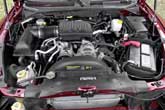
Design
Design Mitsubishi has done a commendable job of masking the Raider’s Dodge Dakota heritage. The 2006 Mitsubishi Raider encounters the same classification hurdle as its Dodge counterpart, as its proportions are essentially identical. Larger in length and wheelbase than a Chevy Colorado, GMC Canyon, Ford Ranger, Nissan Frontier, or Toyota Tacoma – with the exception of the Tacoma Double Cab 4WD. However, positioned beside the full-sized Chevy Silverado, Dodge Ram, Ford F-150, Nissan Titan, or Toyota Tundra, the Raider is clearly medium-sized. Toyota's Regular and “Access Cab” Tundra models are close in dimension, each featuring a wheelbase of 128.3 inches (3 inches less than Mitsubishi) and an overall length of 218.3 inches (1.6 inches less). That said, Mitsubishi departs – at least in terms of styling – from the Dakota. In fact, the only sheet metal in common between the two is the roof panel, windshield, rear side glass and rear doors. The Dodge's oversized crosshair snout has been replaced by Mitsubishi's smaller body-colored grille, the leftover space turned into an air intake above the aggressive looking aluminum-finished lower bumper, which is designed to look like a skid plate. Like the grille, Mitsubishi's headlights are not as substantial as those on the Dodge and are trimmed with thick chrome below the lamps. On the Dakota, the fog lamps look better integrated into the lower bumper, seemingly undersized on the Raider because of the massive gray-colored bumper extensions. The Raider’s DuroCross trim level brings more aggressive fender flares reminiscent of the Mitsubishi Endeavor, skid plates, and more distinct trim, inside and out.
Mitsubishi's interior layout echoes the Dakota, and the standout characteristic is the ability to seat up to six passengers in Double Cab models, although we would recommend short distances when traveling with the additional sixth rider. Mitsubishi’s main competition – Nissan and Toyota – can only seat five passengers.
Stepping into the Raider, you’ll find a clean, open, highly styled cabin with some trim pieces that are similar to the Ford F-150’s, although they are “common parts” from the Mitsubishi suv stable. Interior highlights include circular dash-mounted vents, steering wheel controls built into – rather than tacked onto – the wheel and three main easy-to-read gauges in the center cluster. Knobs and controls are large, and are arranged in a simple layout, with the average number of cubbies and bins for stowage, along with a small glovebox.
While Mitsubishi designers call their interior materials “premium,” we found the composite plastic in the cabin hard to the touch and would call the headliner material outdated mouse fur. Other complaints focused on the second-class treatment of rear passengers. Grab handles incorporated into the A-pillars ease entry for front seat occupants, but rear-seat passengers have a tall step-up without the optional side rail trim, and no grab handles exist to assist with entry and exit.
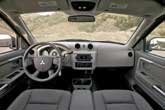
Safety and Technology
Safety and Technology Side curtain airbags are optional on the 2006 Mitsubishi Raider Double Cab, and you also get six months of free Sirius satellite radio. Safety features on the 2006 Mitsubishi Raider include dual-stage frontal airbags with occupant sensing and an optional Security Package on Double Cab models includes curtain airbags for both rows, ABS, a security system, and an engine immobilizer. Offering curtain airbags as an option matches the import competition, however, Nissan and Toyota offer seat-mounted front side-impact airbags, whereas Mitsubishi does not. Upscale technology features include the hands-free Bluetooth cell-phone communications system and Sirius satellite radio. Mitsubishi will pay the satellite radio subscription for the first six months, allowing customers to sample the service before committing for a longer term.
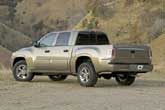
Driving Impressions
Driving Impressions Not surprisingly, the 2006 Mitsubishi Raider drives just like a Dodge Dakota, which is a good thing. We drove both 2WD and 4WD versions of the 2006 Mitsubishi Raider in both Extended and Double Cab fitment, finding the V6, with its four-speed automatic, amply-powered for everyday stow-‘n-go and rubbernecking at majestic scenery. However, we would recommend the V8, with the five-speed automatic, for buyers with serious hauling and towing needs. We did not try out the six-speed manual transmission in the Raider, but from our previous experience in the Dakota version, we know it to be a somewhat wide and long-throw gearbox, with taller gears in the top end and short first and second gears for decent off-the-line response.
Although mid-sized and impressively refined, there’s no calling the Raider a luxury ride. But in its Double Cab clothing, the Raider’s cockpit has the feel of an SUV, with steering, braking and handling characteristics that allowed for decent maneuverability and stopping power over a course of more than 150 miles. Our short off-road trial reminded us that a simple twist of a dial engages 4WD for increased backcountry capability, lowering a boat or other watercraft into the water at steep angles, or traveling on terrain with modest levels of traction.
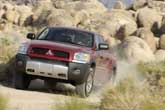
Wrap-Up and Specs
Wrap-Up and Specs Mitsubishi re-skins a Dodge Dakota to craft its first pickup truck in 10 years. Highlights include muscular styling, an optional V8 engine, and six-passenger seating. SPECIFICATIONS Test Vehicle: 2006 Mitsubishi Raider Base price range: $19,500 – $30,000 (estimated) Engine Size and Type: 3.7-liter V6 (LS, DuroCross V6); 4.7-liter V8 (DuroCross V8, XLS Double Cab) Engine Horsepower: 210 at 5,200 rpm (V6); 230 at 4,600 rpm (V8) Engine Torque: 235 lb.-ft. at 3,600 rpm (V6); 290 lb.-ft. at 3,600 rpm (V8) Transmission: Six-speed manual or four-speed automatic (V6); five-speed automatic (V8) Curb weight, lbs.: 4,300 est. (LS Extended Cab with V6 and manual transmission) to 4,800 est. (XLS Double Cab V8) EPA Fuel Economy (city/highway): 16/22 mpg (2WD V6 manual); 16/20 mpg (4WD V6 manual); 17/22 mpg (2WD V6 auto.); 15/19 (4WD V6 auto.); 15/20 mpg (2WD V8 auto.); 14/19 mpg (4WD V8 auto.) Wheelbase: 131.3 inches Length: 219.9 inches Width: 71.9 inches Height: 68.6 inches Max. Seating Capacity: Five (Extended Cab); Six (Double Cab) Head room (front/rear): 39.6/36.5 inches (Extended Cab); 39.9/38.4 inches (Double Cab) Leg room (front/rear): 41.9/32.1 inches (Extended Cab); 41.9/36.4 (Double Cab) Cab cargo volume: 30 cubic feet (Extended Cab); 37.1 cubic feet (Double Cab) (rear seats folded) Max towing capacity: 6,500 lbs. Max payload: 1,200 – 1,700 lbs. (depending on curb weight) Ground clearance: 7.9 inches Competitors: Chevrolet Colorado, Chevrolet Silverado, Dodge Dakota, Dodge Ram, Ford F-150, Ford Ranger, GMC Canyon, GMC Sierra, Nissan Frontier, Nissan Titan, Toyota Tacoma, Toyota Tundra

FAQs
FAQs Why buy a Dodge? Higher-horsepower V8 option, more dealers, and styling differences. But that Mitsubishi warranty is compelling… If the 2006 Mitsubishi Raider is the same as the Dodge Dakota but with a better warranty, why choose the Dodge? Dodge offers a higher-horsepower V8 engine option for maximum towing and hauling capacity. And if the Raider’s styling turns you off, the Dodge might be more appealing. Plus, there are lots more Dodge dealers in the U.S. than there are Mitsubishi dealers, just in case you need work done. Why does Mitsubishi need a truck in showrooms? Shouldn’t the company be focused on higher volume segments of the market? Ever since the Mighty Max expired after the 1995 model year, Mitsubishi dealers have been clamoring for a pickup truck. Now they’ve got one, thanks to collaboration between DaimlerChrysler and Mitsubishi. But with that corporate relationship on the ropes, the Raider might be a short-lived solution to the problem. Can any Dodge dealer service my 2006 Mitsubishi Raider? Once the warranty expires, any Dodge dealer will be able to service the Raider since it’s the same as the Dakota under the sheet metal. But during the warranty period, you’re going to need to find a Mitsubishi dealer if you want a free fix.
Photos courtesy of Mitsubishi Motor Sales America
